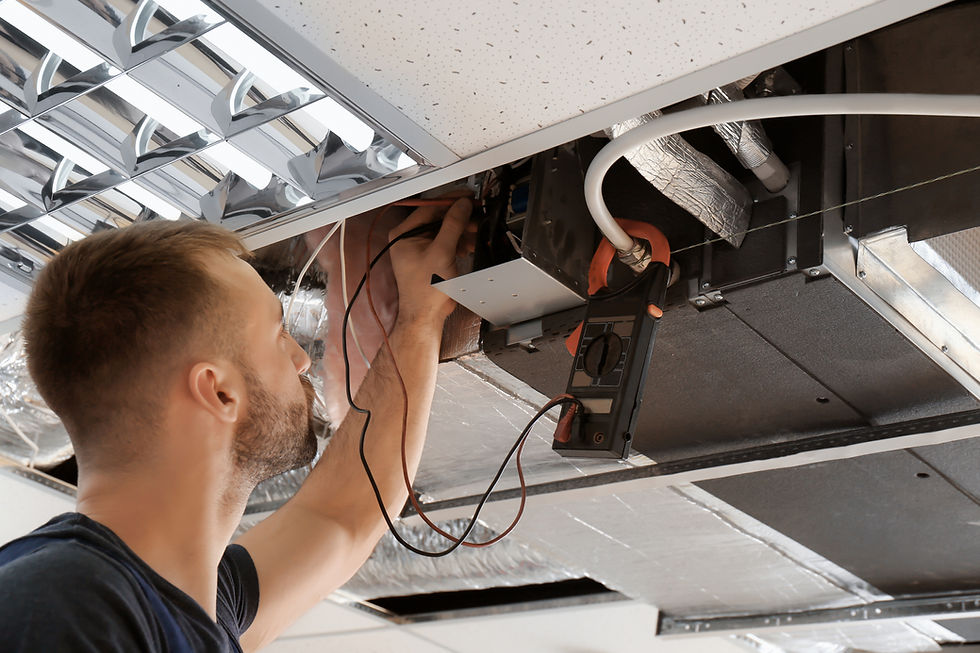Best Practices for Installing Cabling, HVAC and Lighting Above Suspended Ceilings
- DLS Interiors
- Sep 22
- 3 min read
In modern commercial and technical buildings, suspended ceilings are more than just a clean finish. They are an essential part of the building infrastructure, creating a concealed space for services such as cabling, HVAC (heating, ventilation and air conditioning), and lighting.
When designed and installed correctly, ceiling grids allow these systems to remain accessible, compliant and efficient. At DLS Interiors, we install high-performance ceiling systems across Ireland and Europe, including Zentia lay-in ceilings, CasoLine MF systems, SAS metal ceilings, Gordon and Tate grids, and Unistrut structural systems.
This blog explores the best practices for integrating cabling, HVAC and lighting above suspended ceilings, focusing on performance, compliance and long-term value.

1. Cabling Above Suspended Ceilings
What is it?
Cabling in commercial properties typically includes electrical wiring, data cables, fibre optics, and fire alarm lines. Suspended ceilings create a concealed plenum space where these systems can run discreetly.
Best Practices:
Load Support: Heavy cabling should never rest directly on ceiling tiles. Systems such as Unistrut and Tate Grid provide dedicated structural support.
Segregation: Data, power, and fire cabling should be properly separated to avoid interference and maintain compliance.
Accessibility: Routes should be designed for easy maintenance without damaging ceiling finishes.
Benefits:
Keeps interiors neat and professional
Improves compliance with building regulations
Allows for flexible upgrades as technology evolves
2. HVAC Systems Above the Grid
What is it?
HVAC ductwork, diffusers, and air handling equipment are often housed within the ceiling void. Suspended ceilings conceal this equipment while maintaining access for servicing.
Best Practices:
Weight Management: Large ducts must be supported by structural systems such as Unistrut, not the ceiling grid itself.
Integration: MF ceilings and SAS systems can be designed with cut-outs for diffusers, grilles and vents.
Airflow Control: Ensure airtight sealing around penetrations to maintain fire integrity and acoustic performance.
Benefits:
Enhances comfort and air quality
Maintains visual appeal with discreet vents
Meets compliance for fire, acoustic and energy standards
3. Lighting Above and Within Ceilings
What is it?
Lighting fixtures are commonly integrated into ceiling grids, whether recessed LED panels, downlights or suspended linear systems.
Best Practices:
Fixture Compatibility: Choose ceiling systems such as Zentia or SAS that support modular LED lighting.
Load Ratings: Heavier lighting installations should be supported by Unistrut or Gordon grids.
Maintenance Access: Lighting layouts should allow tiles or panels to be removed easily for service access.
Benefits:
Creates modern, energy-efficient workspaces
Improves safety and visual comfort
Enhances productivity in offices and technical facilities
Key Insights
Load Classes Are Critical: Only structural grids such as Unistrut or Tate Grid should support heavy cabling or HVAC equipment.
Fire and Acoustic Integrity: Penetrations in MF or SAS ceilings must be sealed to preserve performance.
Future-Proofing: Early coordination between ceiling contractors and M&E teams reduces delays, clashes and rework.

Conclusion
Suspended ceiling systems do more than improve aesthetics. They are the backbone of modern building services, supporting electrical cabling, HVAC systems and integrated lighting. By choosing the right ceiling grid whether Zentia, CasoLine MF, SAS, Gordon or Tate, contractors can ensure compliance, safety and long-term efficiency.
At DLS Interiors, we bring over 20 years of experience to ceiling installations across Dublin, Ireland and Europe. Our team works with contractors, developers and end clients to deliver safe, compliant and future-ready ceiling systems.
FAQs
1. Can suspended ceilings support heavy cable trays?
Not directly. Heavy services should be supported by structural systems such as Unistrut or Tate Grid, designed for load-bearing applications.
2. Do HVAC ducts affect the fire rating of ceilings?
Yes. Any penetrations must be sealed with fire-rated materials to maintain compliance. DLS Interiors ensures all installations meet regulations.
3. Are LED lights suitable for all ceiling types?
Yes, but heavier fixtures may require additional support. Zentia and SAS ceilings integrate particularly well with modular LED panels.
4. How do ceiling grids improve acoustic performance?
Systems such as Zentia and SAS use acoustic tiles and perforated panels with backing materials to reduce noise transfer and echo.
5. Do you install ceilings outside Dublin?
Yes. We provide ceiling and partition installation services nationwide across Ireland and throughout Europe.


